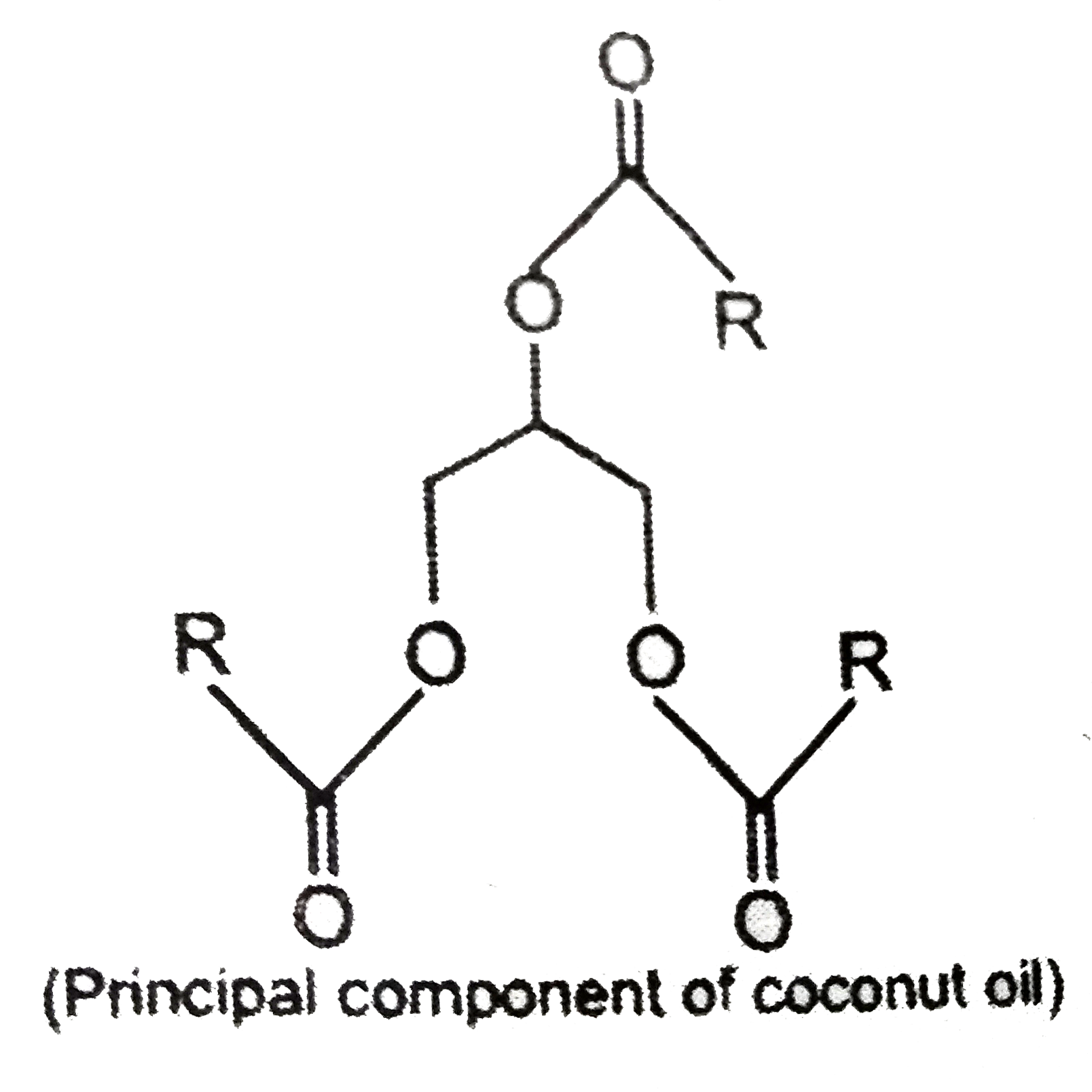Consider the folliwng reactions:
I. Me3C−BrH2O+NaBr−−−−−−−−−→SN1Product
II. Ph3C−BrH2O+NaBr−−−−−−−−−→SN1Products
Which of the folliwng statements are correct about the above reactions?
The products in reactions (I) and (II) are mixture of (Me3−OH+Me3Br) and (Ph3C−OH+Ph3C−Br), respectively.
The product is (I) is (Me3C−OH) and in (II) is (Ph3C−OH+Ph3C−Br).
The product in (I) is (Me3C−OH+Me3C−Br0 and in (II) is (Ph3C−OH).
Ph3C⊕ is more stable than MeC⊕.
The correct Answer is:(b,d)
To analyze the given reactions and determine the correct statements, we will break down the reactions step by step.
Step 1: Analyze Reaction I
The first reaction involves a tertiary alkyl bromide, Me3C−Br, undergoing an SN1 reaction with water (H2O) and sodium bromide (NaBr).
1. Formation of Carbocation: The tertiary alkyl bromide will first undergo ionization to form a tertiary carbocation (Me3C+). This step is the rate-determining step in an SN1 mechanism.
Hint: Tertiary carbocations are more stable due to hyperconjugation and inductive effects.
2. Nucleophilic Attack: The water molecule acts as a nucleophile and attacks the carbocation, leading to the formation of a tertiary alcohol (Me3C−OH).
Hint: In SN1 reactions, the nucleophile attacks the carbocation after its formation.
Step 2: Analyze Reaction II
The second reaction involves a triphenylmethyl bromide, Ph3C−Br, also undergoing an SN1 reaction with water and sodium bromide.
1. Formation of Carbocation: The triphenylmethyl bromide will ionize to form a benzylic carbocation (Ph3C+). This carbocation is highly stabilized by resonance due to the three phenyl groups attached to it.
Hint: Resonance stabilization significantly increases the stability of carbocations.
2. Nucleophilic Attack: Similar to the first reaction, water will attack the benzylic carbocation, forming triphenylmethanol (Ph3C−OH). However, due to the partial double bond character of the carbon-bromine bond in aryl halides, the reaction is less favorable, and the product may be formed in minor amounts.
Hint: Aryl halides are less reactive in SN1 reactions due to the strength of the C-Br bond.
Step 3: Evaluate the Statements
Now we will evaluate the statements based on our analysis of the reactions:
1. Statement A: Product one is a mixture of products.
- Evaluation: This statement is incorrect. Product one is a single tertiary alcohol (Me3C−OH).
2. Statement B: Product one is a tertiary alcohol while product two is a mixture.
- Evaluation: This statement is correct. Product one is indeed a tertiary alcohol, and product two (triphenylmethanol) is formed in minor amounts.
3. Statement C: Benzyl carbocation is more stable than tertiary carbocation.
- Evaluation: This statement is correct. The benzylic carbocation is resonance-stabilized by three phenyl groups, making it more stable than the tertiary carbocation.
4. Statement D: The reaction of triphenylmethyl bromide does not proceed via SN1 due to the partial double bond character.
- Evaluation: This statement is partially correct. While the reaction does proceed via SN1, it is less favorable due to the strong C-Br bond in aryl halides.
Final Conclusion
Based on the evaluations:
- Correct Statements: B and C.
- Incorrect Statements: A and D.
Summary of the Solution
1. Reaction I: Forms a tertiary alcohol (Me3C−OH).
2. Reaction II: Forms triphenylmethanol (Ph3C−OH) but is less favorable due to the strength of the C-Br bond.
3. Correct Statements: B and C.
The first reaction involves a tertiary alkyl bromide, Me3C−Br, undergoing an SN1 reaction with water (H2O) and sodium bromide (NaBr).
Hint: Tertiary carbocations are more stable due to hyperconjugation and inductive effects.
The second reaction involves a triphenylmethyl bromide, Ph3C−Br, also undergoing an SN1 reaction with water and sodium bromide.
Now we will evaluate the statements based on our analysis of the reactions:
- Evaluation: This statement is incorrect. Product one is a single tertiary alcohol (Me3C−OH).
- Evaluation: This statement is correct. Product one is indeed a tertiary alcohol, and product two (triphenylmethanol) is formed in minor amounts.
- Evaluation: This statement is correct. The benzylic carbocation is resonance-stabilized by three phenyl groups, making it more stable than the tertiary carbocation.
- Evaluation: This statement is partially correct. While the reaction does proceed via SN1, it is less favorable due to the strong C-Br bond in aryl halides.
Based on the evaluations:
- Correct Statements: B and C.
- Incorrect Statements: A and D.
1. Reaction I: Forms a tertiary alcohol (Me3C−OH).
2. Reaction II: Forms triphenylmethanol (Ph3C−OH) but is less favorable due to the strength of the C-Br bond.
3. Correct Statements: B and C.
Topper's Solved these Questions
- AROMATIC COMPOUNDS AND ALKYL AND ARYL HALIDES Book:CENGAGE CHEMISTRY ENGLISHChapter:AROMATIC COMPOUNDS AND ALKYL AND ARYL HALIDES Exercise:Exercises Multiple Correct Answers Type
Explore 15 Videos
- AROMATIC COMPOUNDS AND ALKYL AND ARYL HALIDES Book:CENGAGE CHEMISTRY ENGLISHChapter:AROMATIC COMPOUNDS AND ALKYL AND ARYL HALIDES Exercise:Exercises Single Correct Answer Type
Explore 28 Videos
- AROMATIC COMPOUNDS AND ALKYL AND ARYL HALIDES Book:CENGAGE CHEMISTRY ENGLISHChapter:AROMATIC COMPOUNDS AND ALKYL AND ARYL HALIDES Exercise:Exercises Linked Compreshension Type
Explore 11 Videos
- APPENDIX INORGANIC VOLUME 2Book:CENGAGE CHEMISTRY ENGLISHChapter:APPENDIX INORGANIC VOLUME 2Exercise:Short Answer Type
Explore 179 Videos
- BIOMOLECULESBook:CENGAGE CHEMISTRY ENGLISHChapter:BIOMOLECULESExercise:Exercises Archives (Analytical And Descriptive)
Explore 8 Videos
Similar Questions
Knowledge Check
Ph−CH2−CH∣D−CH3Br2/hv−−−−→
Product of the above reaction will be :ADiastereomersBRacemic mixtureCMesoDConstitutional isomersWhat is the major product of the following reaction ?
CH3−C≡NCH3MgI−−−−→Et2OH3O⊕−−−→ACH3−CH2−NH−CH3B CCH3−O∣∣C−CH3DCH3−CH2−O∣∣C−OH
CCH3−O∣∣C−CH3DCH3−CH2−O∣∣C−OH
MeCH2COOH(A)(i)SOCI−−−−−−−→(ii)CH2N2(iii)Ag2O/Pt(B)H2O−−→(C)
Which of the following statements are correct about the given reaction.
View Solution NaOH,H2O−−−−−−−→100∘C(Several hours)Product Product is obtained in the above reaction is :
NaOH,H2O−−−−−−−→100∘C(Several hours)Product Product is obtained in the above reaction is :
View SolutionThe major product formed in the following reation is
CH3−CH3∣C∣H−CH2−BrCH3ONa−−−−−→CH3OH .
View SolutionComplete the following reactions:
Propane nitrile(N)(i)PhMgBr−−−−−−−−−→(ii)H3O⊕(O)Zn−Hg−−−−−−−→HCl(P)
View SolutionIn the reaction sequence
CH3−O∣∣C−H−HCN−−−→.ΘOH(A)H2O/⊕H−−−−→Δ Product is/are :
View SolutionConsider the following reaction.
CH3O16∣∣C−O18−C2H5+H2O16H+−−→Heat
The products formed in the reaction are
View Solution